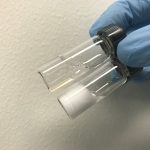 Things that are fairly run-of-the-mill for many people are cause for alarm for diabetics. Scratches and scrapes, for instance, can easily turn into an open wound that could have serious implications.
Things that are fairly run-of-the-mill for many people are cause for alarm for diabetics. Scratches and scrapes, for instance, can easily turn into an open wound that could have serious implications.
A team from Northwestern University have developed a regenerative bandage that they believe heals these challenging sores without relying on drugs. Indeed, when put head to head with leaving bandages currently on the market, the new product healed the wound 33% faster.
“The novelty is that we identified a segment of a protein in skin that is important to wound healing, made the segment and incorporated it into an antioxidant molecule that self-aggregates at body temperature to create a scaffold that facilitates the body’s ability to regenerate tissue at the wound site,” the team say. “With this newer approach, we’re not releasing drugs or outside factors to accelerate healing. And it works very well.”
Healing power
The bandage aims to tap into the healing power of the body without relying on either drugs or biologics. The team believe this will help it get to market without facing so many regulatory hurdles.
The magic behind the technology is a protein known as laminin. This is found in most of the body’s tissues and sends various signals to cells that encourage them to differentiate, migrate and adhere to one another. A particular segment of laminin, known as A5G81, is crucial to the wound-healing process.
“This particular sequence caught our eye because it activates cellular receptors to get cells to adhere, migrate and proliferate,” the researchers say. “Then we cut up the sequence to find the minimum size that we needed for it to work.”
The team believe that by using a small segment of laminin rather than the whole thing, it can be produced in the laboratory more easily, which keeps manufacturing costs low. They were able to use this process to incorporate A5G81 into an antioxident hydrogel bandage. The nature of the bandage counters any inflammation in the wound, whilst the hydrogel is thermally responsive that solidifies when exposed to body temperature. This helps it to conform exactly to the shape of the wound.
“Wounds have irregular shapes and depths. Our liquid can fill any shape and then stay in place,” the researchers say. “Other bandages are mostly based on collagen films or sponges that can move around and shift away from the wound site.”
User friendly
The device also aims to fit in with the requirements from users, most of whom have to frequently change and update their bandages. This can cause them to rip off any healing tissue and cause the wound to deteriorate. The new bandage can be rinsed off with a cool saline, hence retaining the regenerating tissue intact.
The team are also confident that the lack of drugs or biologics will speed up the route to market, whilst also increasing the safety of the bandage. In initial testing, there have been no adverse effects in animals, and they’re confident this will also be the case on humans.
The next phase will be to explore the impact of the bandage in a large pre-clinical trial.